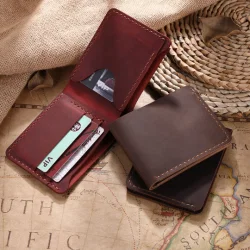Here are some common types of wallets
2023-12-18
Wallets are personal accessories designed to hold and organize items such as cash, credit cards, identification, and other essentials. They come in various styles, materials, and sizes to suit different preferences and needs. Here are some common types of wallets:
1. Bifold Wallet:
- Design: Folds in half, typically featuring card slots on both sides and a bill compartment.
- Usage: Suitable for those who prefer a slim and compact wallet for essentials.
2. Trifold Wallet:
- Design: Folds into three sections, providing additional storage space for cards and sometimes coins.
- Usage: Offers more organization and storage options, but can be bulkier compared to bifolds.
3. Slim/Minimalist Wallet:
- Design: Compact and streamlined, designed to carry only essential items like a few cards and cash.
- Usage: Ideal for those who prefer a minimalist and lightweight option.
4. Money Clip Wallet:
- Design: Features a clip on the outside for securing cash, along with card slots.
- Usage: Suited for individuals who primarily use cards but still want the option to carry cash.
5. Cardholder:
- Design: A small, slim wallet designed specifically for holding cards.
- Usage: Ideal for those who prefer a minimalist approach and primarily use cards for transactions.
6. Travel Wallet:
- Design: Typically larger and designed to hold passports, travel documents, and cards.
- Usage: Ideal for frequent travelers who need a secure and organized way to carry essential documents.
7. Zip-around Wallet:
- Design: Features a zipper that goes around the wallet, providing additional security.
- Usage: Offers extra protection for cards and cash, preventing items from accidentally falling out.
8. Checkbook Wallet:
- Design: Includes a compartment for a checkbook, along with card slots and a bill compartment.
- Usage: Suited for those who still use checks or need to carry a checkbook for specific transactions.
9. Phone Wallet/Case:
- Design: Combines a wallet with a phone case, allowing users to carry cards and a phone in one accessory.
- Usage: Convenient for those who want to consolidate their phone and wallet.
10. RFID Blocking Wallet:
- Design: Equipped with RFID-blocking technology to protect cards from unauthorized scanning.
- Usage: Ideal for security-conscious individuals who want to prevent electronic theft of their card information.
11. Chain Wallet (Biker Wallet):
- Design: Includes a chain that can be attached to a belt loop, providing extra security.
- Usage: Often associated with a biker or edgy aesthetic, offering added protection against theft or loss.
12. Digital Wallet (Smart Wallet):
- Design: Incorporates technology such as Bluetooth to help locate the wallet or track its last known location.
- Usage: Suited for individuals prone to misplacing their wallet or wanting additional security features.
Materials Used in Wallets:
- Leather: Commonly used for its durability and classic appearance. Types include full-grain, top-grain, and genuine leather.
- Synthetic Materials: Alternatives to leather, such as nylon, polyester, or faux leather, offering different textures and colors.
- Canvas: A durable and lightweight fabric often used for casual and sporty wallet designs.
- Metal: Some minimalist wallets or cardholders are made of metal for a modern and industrial look.
- RFID-Blocking Materials: Often integrated into wallet designs to prevent electronic theft of card information.
When choosing a wallet, considerations may include the number of cards and cash you typically carry, the desired level of organization, and the overall aesthetic and material preferences. Wallets are not only functional but also a reflection of personal style and taste.



